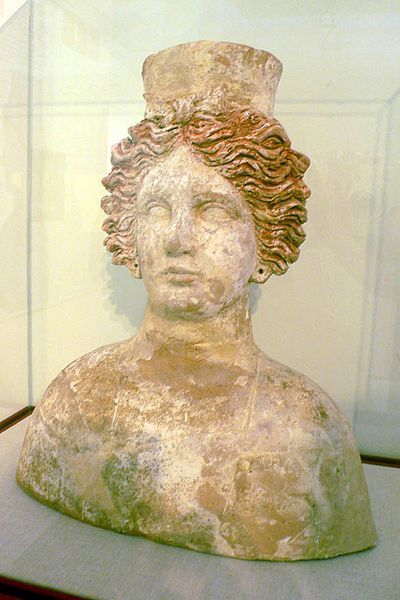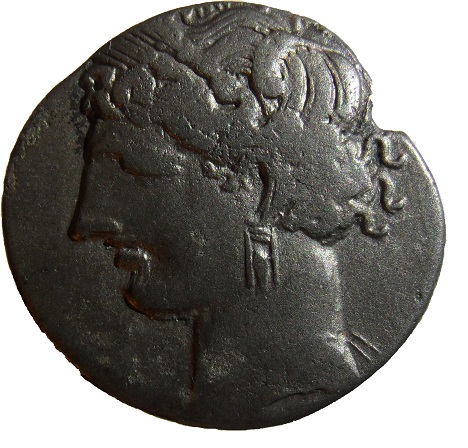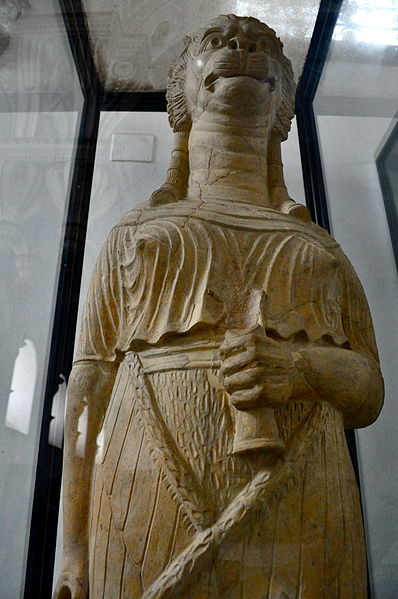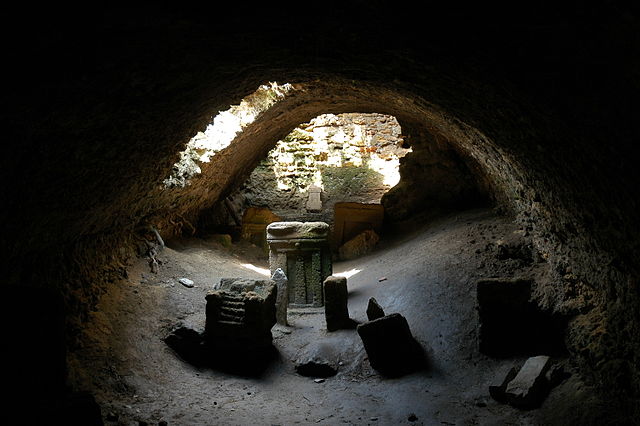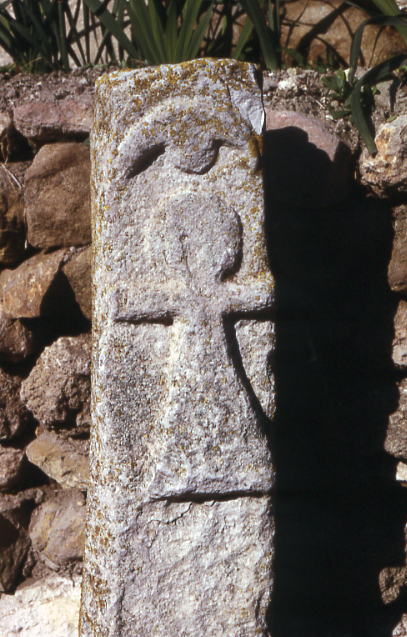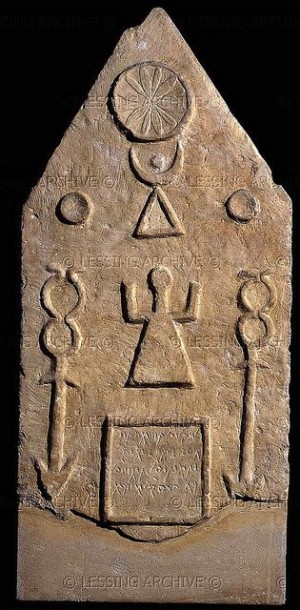
| TANIT
Bust of Tanit found in the Carthaginian necropolis of Puig des Molins, dated 4th century BC, housed in the Museum of Puig des Molins in Ibiza, Spain Tanit was a Punic and Phoenician goddess, she was the chief deity of Carthage alongside her consort Baal-Hamon. She was adopted by the Amazigh people.
Tanit is also called Tinnit. The name appears to have originated in Carthage (modern day Tunisia), though it does not appear in local theophorous names. She was equivalent to the war goddess Astarte, and later worshipped in Roman Carthage in her Romanized form as Dea Caelestis, Juno Caelestis, or simply Caelestis.
In modern-day Tunisian Arabic, it is customary to invoke Omek Tannou or Oumouk Tangou ('Mother Tannou' or 'Mother Tangou', depending on the region), in years of drought to bring rain. Similarly, Tunisian and many other spoken forms of Arabic refer to "Baali farming" to refer to non-irrigated agriculture.
Worship :
A Punic coin featuring Tanit, minted in Punic Carthage between 215 and 205 BCE Tanit was worshiped in Punic contexts in the Western Mediterranean, in Sicily, Malta, North Africa, Gades and many other places into Hellenistic times. From the fifth century BCE onwards, Tanit's worship is associated with that of Baal Hammon. She is given the epithet pene baal ('face of Baal') and the title rabat, the female form of rab ('chief'). In North Africa, where the inscriptions and material remains are more plentiful, she was, as well as a consort of Baal-hamon, a heavenly goddess of war, a "virginal" (unmarried) mother goddess and nurse, and, less specifically, a symbol of fertility, as are most female forms. Several of the major Greek goddesses were identified with Tanit by the syncretic interpretatio graeca, which recognized as Greek deities in foreign guise the gods of most of the surrounding non-Hellene cultures.
Tanit with a lion's head Her shrine excavated at Sarepta in southern Phoenicia (modern-day Lebanon) revealed an inscription that has been speculated, but as of yet not proven, to identify her for the first time in her homeland and related her securely to the Phoenician goddess Astarte (Ishtar). One site where Tanit is uncovered is at Kerkouane, in the Cap Bon peninsula in Tunisia.
Archaeological evidence :
Stelae in the Tophet of Salammbó covered by a vault built in the Roman period Tophet is a Hebrew term from the Bible, used to refer to a site near Jerusalem at which Canaanites and Israelites who strayed from Judaism by practicing Canaanite idolatry were said to sacrifice children. It is now used as a general term for all such sites with cremated human and animal remains. The Hebrew Bible does not specify that the Israelite victims were buried, only burned, although the "place of burning" was probably adjacent to the place of burial. We have no idea how the Phoenicians themselves referred to the places of burning or burial, or to the practice itself.
Several apparent tophets have been identified, chiefly a large one in Carthage, dubbed the Tophet of Salammbó, after the neighbourhood where it was unearthed in 1921. Soil in the Tophet of Salammbó was found to be full of olive wood charcoal, probably from the sacrificial pyres. It was the location of the temple of the goddess Tanit and the necropolis. Animal remains, mostly sheep and goats, found inside some of the Tophet urns, strongly suggest that this was not a burial ground for children who died prematurely. The animals were sacrificed to the gods, presumably in place of children (one surviving inscription refers to the animal as "a substitute"). It is conjectured that the children unlucky enough not to have substitutes were also sacrificed and then buried in the Tophet. The remains include the bodies of both very young children and small animals, and those who argue in favor of child sacrifice have argued that if the animals were sacrificed then so too were the children. The area covered by the Tophet in Carthage was probably over an acre and a half by the fourth century BCE, with nine different levels of burials. About 20,000 urns were deposited between 400 BCE and 200 BCE, with the practice continuing until the early years of the Christian period. The urns contained the charred bones of newborns and in some cases the bones of fetuses and two-year-olds. These double remains have been interpreted to mean that in the cases of stillborn babies, the parents would sacrifice their youngest child.
A detailed breakdown of the age of the buried children includes pre-natal individuals – that is, still births. It is also argued that the age distribution of remains at this site is consistent with the burial of children who died of natural causes, shortly before or after birth. Sergio Ribichini has argued that the Tophet was "a child necropolis designed to receive the remains of infants who had died prematurely of sickness or other natural causes, and who for this reason were "offered" to specific deities and buried in a place different from the one reserved for the ordinary dead". He adds that this was probably part of "an effort to ensure the benevolent protection of the same deities for the survivors." However, this analysis is disputed; Patricia Smith and colleagues from the Hebrew University and Harvard University show from the teeth and skeletal analysis at the Carthage Tophet that infant ages at death (about two months) do not correlate with the expected ages of natural mortality (perinatal).
Other usage :
Stele with Tanit's symbol in Carthage's Tophet, including a crescent moon over the figure
Goddess Tanit Stele Tanit with both hands raised represents egyptian symbol Ka. To know more about Ka and raising hands during prayer Click here.
Long after the fall of Carthage, Tanit was still venerated in North Africa under the Latin name of: Juno Caelestis, for her identification with the Roman goddess Juno. [unreliable source] The ancient Berber people of North Africa also adopted the Punic cult of Tanit. Her symbol (the sign of Tanit), found on many ancient stone carvings, appears as a trapezium closed by a horizontal line at the top and surmounted in the middle by a circle; the horizontal arm is often terminated either by two short upright lines at right angles to it or by hooks. Later, the trapezium was frequently replaced by an isosceles triangle. The symbol is interpreted by Danish professor of Semitic philology F. O. Hvidberg-Hansen as a woman raising her hands. Hvidberg-Hansen notes that Tanit is sometimes depicted with a lion's head, showing her warrior quality.
Cultural
references :
In Kate Elliott's Spiritwalker trilogy, a romanticised version of Tanit is one of many deities commonly worshiped in a polytheistic Europa. The narrator, Catherine, frequently appeals to "Blessed Tanit, Protector of Women", and the goddess occasionally appears to her.
G. K. Chesterton refers to Tanit in his account of the Punic Wars, "War of the Gods and Demons" (a chapter of his book The Everlasting Man). Describing the cultural shock of foreign armies invading Italy when Hannibal crossed the Alps, Chesterton wrote :
It was Moloch upon the mountain of the Latins, looking with his appalling face across the plain; it was Baal who trampled the vineyards with his feet of stone; it was the voice of Tanit the invisible, behind her trailing veils, whispering of the love that is more horrible than hate.
In Margaret Atwood's The Blind Assassin there is an epigraph on a Carthaginian funerary urn that reads: "I swam, the sea was boundless, I saw no shore. / Tanit was merciless, my prayers were answered. / O you who drown in love, remember me."
In John Maddox Roberts's alternate history novel Hannibal's Children, in which the Carthaginians won the Second Punic War, one of the characters is Princess Zarabel, leader of the cult of Tanit.
Isaac Asimov's 1956 science fiction short story "The Dead Past" tells of Arnold Potterley, a professor of ancient history, who is obsessed with exonerating the Carthaginians of child sacrifice and tries to gain access to the chronoscope, a device which allows direct observation of past events. Eventually, Potterley's obsession with the Carthaginian past has far-reaching effects on the society of the present.
Given
name :
Analysis from outside wikipedia source :
The Phoenician were Sun worshipping Aryans after the Marriage of Thor / Adam / Indra with Eve / Venus / Astarte (Ishtar) who was a Aryan Goth but raised by The Moon Cult tribe known as Chaldees and Edenites. The Moon Cult was merged with Sun Cult and Animal and Human sacrifice were present in Moon cult from which the Sun worshipping Aryans always kept away.
Since the site was of Tanit it can be that she is Astarte (Ishtar) and the Moon Cult tribe known as Chaldees and Edenites did pratice there animal and human sacrifice.
Source :
https://en.wikipedia.org/ |
